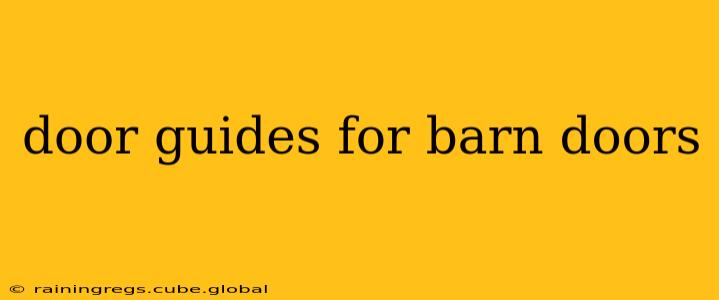Barn doors, with their rustic charm and space-saving design, have become a popular choice for interior design. However, to ensure these doors operate smoothly and prevent damage to both the door and the wall, using high-quality door guides is crucial. This guide explores everything you need to know about choosing and installing the right door guides for your barn door.
What are Barn Door Guides?
Barn door guides are small, but essential hardware components that keep your barn door running smoothly along its track. They prevent the door from swinging, swaying, or derailing, ensuring a consistent and quiet sliding action. These guides are typically attached to the bottom of the door, contacting the floor to prevent unwanted movement. Different types offer varying levels of adjustability and stylistic options to complement your barn door's design.
Types of Barn Door Guides
There's a variety of barn door guides available, each with its own advantages and disadvantages:
Floor Guides:
These are the most common type and attach directly to the floor, typically using screws or adhesive. They offer the best stability and prevent the door from swinging. Variations exist, including:
- Standard Floor Guides: These are simple, often featuring a small, flat base and a small protrusion to guide the door.
- Adjustable Floor Guides: These allow for fine-tuning to ensure perfect alignment and smooth operation. This is particularly useful if your floor isn't perfectly level.
- Flush Floor Guides: These sit nearly flush with the floor, offering a cleaner, more discreet look.
Wall Guides:
Wall guides are less common than floor guides, usually designed for situations where a floor guide isn't feasible (e.g., carpeted floors). They attach to the wall and help prevent the door from swinging away from the track.
Magnetic Floor Guides:
These guides use magnets to hold the door in place, providing a smooth and quiet closing action.
How to Choose the Right Barn Door Guides
Selecting the appropriate barn door guides depends on several factors:
- Door Weight: Heavier doors require more robust guides to maintain stability.
- Floor Type: The type of flooring (hardwood, carpet, tile) will influence the type of guide that will work best and may influence your preference for a floor-mounted vs. wall-mounted option.
- Aesthetic Preferences: Consider how the guides will integrate with your overall design aesthetic. Flush floor guides offer a cleaner look, while more prominent guides may add a touch of rustic charm.
- Adjustability: Adjustable guides are beneficial if your floor isn't perfectly level or if you need to make minor adjustments later on.
How to Install Barn Door Guides?
Installation is usually straightforward, but always consult the manufacturer's instructions. Generally, floor guides involve:
- Marking the Location: Carefully measure and mark the location for the guides on the floor, ensuring they are positioned correctly to align with the door.
- Pre-Drilling (if necessary): Depending on your floor type, you may need to pre-drill pilot holes before screwing in the guides.
- Attaching the Guides: Securely attach the guides to the floor using screws or adhesive, following the manufacturer's instructions.
- Testing the Door: After installation, test the door to ensure it slides smoothly and that the guides are properly aligned.
What if My Barn Door is Still Sticking or Swinging?
Even with properly installed guides, occasional sticking or swinging can occur. This might be due to:
- Uneven Floor: Check for unevenness in your floor and adjust the guides accordingly or consider using shims.
- Door Alignment: Ensure the door is properly aligned within the track.
- Worn-Out Guides: Replace worn-out or damaged guides.
- Track Issues: Inspect the track for debris or damage that could be causing friction.
What are the Best Materials for Barn Door Guides?
Barn door guides are typically made from materials like steel, zinc alloy, or stainless steel. These materials are selected for their durability and resistance to wear and tear. Stainless steel is often favored for its rust resistance, making it suitable for environments with higher humidity.
How Much Do Barn Door Guides Cost?
The cost of barn door guides varies greatly depending on the material, style, and brand. You can expect to find options ranging from a few dollars to several tens of dollars per guide.
By carefully considering the factors outlined above and choosing appropriate barn door guides, you can ensure the smooth, efficient, and long-lasting operation of your beautiful barn door. Remember, a small investment in quality guides can prevent significant problems and protect your investment in your barn door system.
